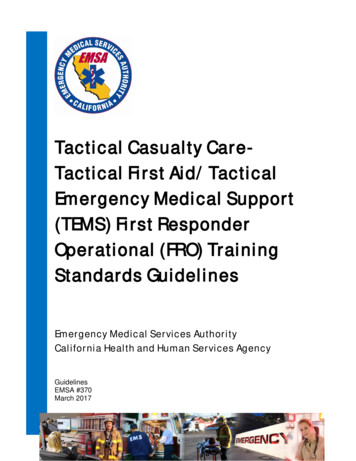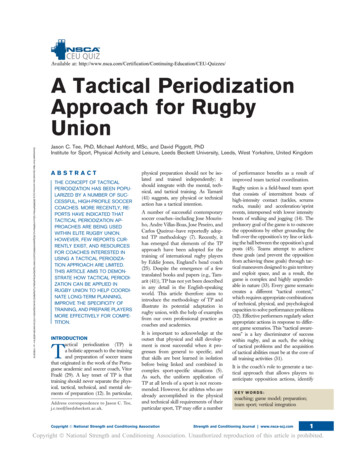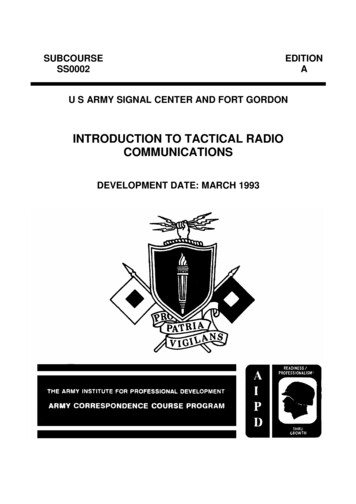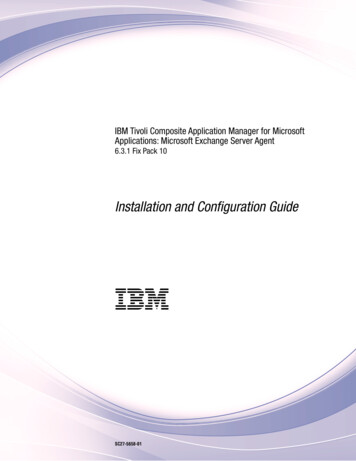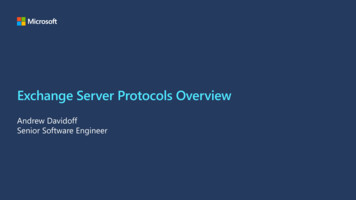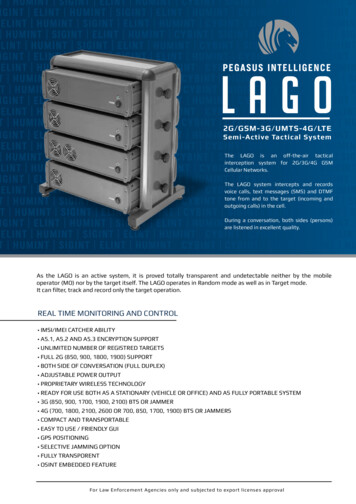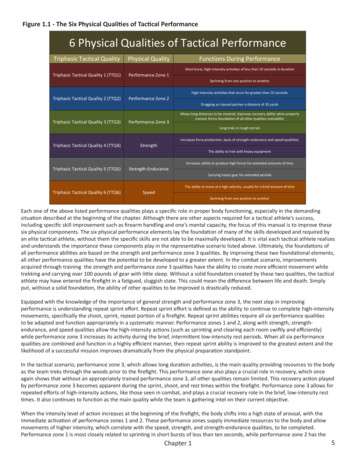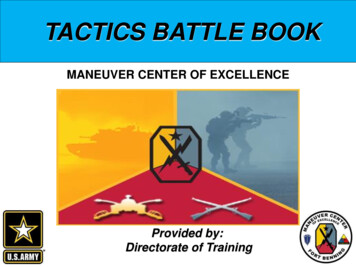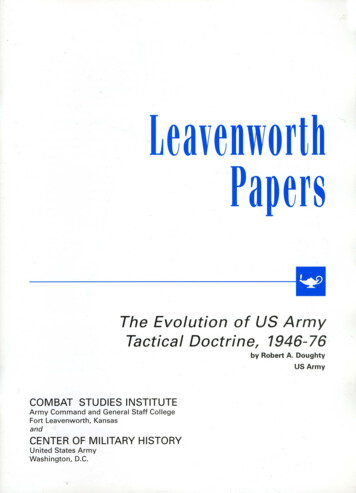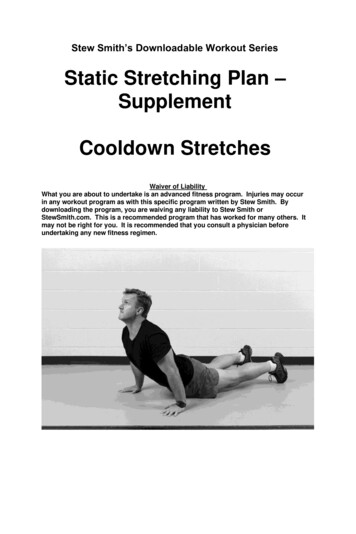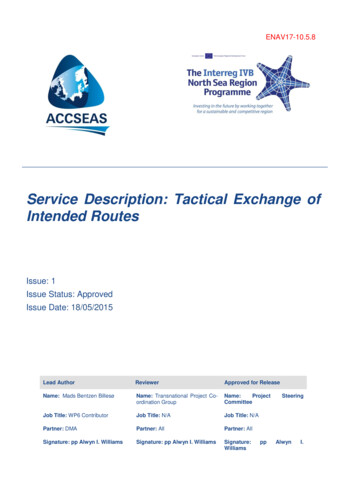
Transcription
ENAV17-10.5.8Service Description: Tactical Exchange ofIntended RoutesIssue: 1Issue Status: ApprovedIssue Date: 18/05/2015Lead AuthorReviewerApproved for ReleaseName: Mads Bentzen BillesøName: Transnational Project Coordination GroupName:ProjectCommitteeJob Title: WP6 ContributorJob Title: N/AJob Title: N/APartner: DMAPartner: AllPartner: AllSignature: pp Alwyn I. WilliamsSignature: pp Alwyn I. WilliamsSignature:WilliamsppSteeringAlwynI.
Service Description: Tactical Exchange of Intended RoutesIssue: 1ApprovedExecutive SummaryEvery ship is by regulation forced to do a berth-to-berth route plan before leaving port (ICS,1998). This intended route resides locked in the navigation system of each ship. By enablingvessels to send and receive each other’s intended routes automatically, and display them ontheir own ECDIS, a possibility to decrease the risk for dangerous situations appears.Further, by making it possible for shore-based services to monitor the intended routes ofvessels, pilots and VTS operators have improved situation awareness and it may bepossible to assist ships unknowingly heading into danger, a situation not quite uncommon.Previously, the EfficienSea project has developed, explored and tested route exchangefunctionality with promising results. As part of the ACCSEAS project, it was decided toimprove and develop these concepts further. Additional functionality, improved userexperience and Maritime Cloud integration has been implemented using the e-NavigationPrototype Display (EPD), and field tests involving ships and shore-side VTS centres togetherwith simulation sessions have been conducted with good results.ACCSEAS ProjectPage 2 of 23
Service Description: Tactical Exchange of Intended RoutesIssue: 1ApprovedContents12Introduction . 51.1Background. 51.2Earlier Tests. 51.3Scope . 6Description of Developed Service. 72.1Creating and Modifying Routes . 72.2Route Manager . 72.3Active Route . 82.4Intended Routes . 82.4.1Intended Route Broadcasting. 92.4.2Intended Route Display . 92.534Closest Point of Approach (CPA) . 112.5.1CPA Warnings . 112.5.2CPA Guidance . 12Technical Implementation. 133.1.1EPD . 133.1.2Maritime Cloud. 133.2Intended Route Broadcast Model . 143.3Intended Route Broadcast Implementation . 14Observations and Feedback. 164.1Simulations . 164.1.1Conceptual level . 164.1.2Procedural level . 184.1.3Functional level . 184.1.4HMI level. 184.1.5Survey . 214.1.6Discussion . 214.1.7Conclusions . 224.2Live tests/demonstrations Humber . 23ACCSEAS ProjectPage 3 of 23
Service Description: Tactical Exchange of Intended RoutesIssue: 1ApprovedDocument DisclaimerDocument is uncontrolled when removed from iManage (either electronic or printed)Document InformationProject TitleACCSEASWork Package No.6Document TitleService Description: Tactical Exchange of Intended RoutesDescriptionThis document describes the results of the efforts in developingand testing the Tactical Exchange of Intended Route service.Date[Publish Date]Lead AuthorMads Bentzen BillesøLead Author’s ContactInformationSøfartsstyrelsen / Danish Maritime AuthorityMaritime Analysis, Technology and Business Development (MAF),e-NavigationTelephone: 45 9137 6329E-mail: MCB@dma.dkContributing Author(s)WP6 ContributorsiManage Location29918Circulation1. Client2. Project Files (i-manage)3. Transnational Project Co-ordination Group4. Project Steering CommitteeNSRP SecretariatApprovalACCSEAS ProjectYes / NoPage 4 of 23
Service Description: Tactical Exchange of Intended RoutesIssue: 11 Introduction1.1Background“What is your intention?” is a common question over the VHF when two ships are indoubt of each other’s intentions. Misunderstanding each other’s intentions is notseldom the cause of accidents at sea. Even worse is when ships in doubt do not askfor intentions, but instead make a presumption.Liu and Wu (2003) studied 100 collision reports from the maritime authorities of theUK, USA, Australia, Canada, New Zealand and Sweden. They found thatcommunication problems were one of the most prominent causes of accidents at sea.The most frequently identified causes were lack of communication and misinterpretinginformation. Underlying human factor issues, they concluded, were the reluctance ofnavigators to exchange information.Every ship is by regulations forced to do a berth-to-berth route plan before leaving port(ICS, 1998). This intended route resides locked in the navigation system of each ship.By enabling vessels to send and receive each other’s intended routes, and displaythem on their own ECDIS, a possibility to decrease the risk for conflicting situationsappears. Further, by making it possible for shore-based services to send routes tovessels, pilots and VTS operators can assist ships unknowingly heading into danger, asituation not quite uncommon.About 33 000 to 35 000 ships over 300 GT pass every year the Sound betweenSweden and Denmark (not counting the many ferries going back and forward acrossthe Sound). In later years there have occurred between 50 and 70 incidents every yearwhere VTS operators have been forced to take action, mostly to warn ships with toodeep draughts or heading for shallows (Garbebring, 2011). In this way it is possible tocreate a unified navigation team by joining the ship’s bridge team and the shore-basedVTS team by new technology to share information.Tactical Exchange of Intended Routes should be seen as a supplement to traditionalVHF voice communication which is subject to misunderstandings due to languageproblems, lacking situation awareness, wrong interpretation of surroundings andhuman error.1.2Earlier TestsPreviously, the EfficienSea and MONALISA projects have developed, explored andtested route exchange functionality using the e-Navigation Prototype Display (EPD).This involved concepts such as: Intended route exchange: A ships currently active route is broadcast via AIS toother ships and shore centres in range.Route suggestion service: A shore-based VTS centre may send a suggestedroute to a vessel via AIS. The vessel can see the suggested route and reject oraccept the proposal.Strategic route exchange: A vessel can send a proposed voyage plan to anearby shore-based VTS centre. Subsequently, the involved VTS centre andvessel can send amended route proposals back and forth; ‘negotiate’, until bothparties have accepted or rejected the voyage plan.ACCSEAS ProjectPage 5 of 23Approved
Service Description: Tactical Exchange of Intended Routes1.3Issue: 1ScopeAs part of the ACCSEAS project, it was decided to improve and develop theseconcepts further.Using AIS as the means of route exchange has substantial advantages. However, inpractice it has turned out to be too fragile, due to the limitations in the protocol andpoor robustness of delivery. In the ACCSEAS project, all services have been migratedto use the Maritime Cloud Maritime Messaging Service (MMS) as the means ofcommunication – see Annex on Maritme Cloud for further details).To improve the user experience, the route exchange services, along with othermaritime services such as MSI, messaging, and general notifications, have beenintegrated into a unified Notification Centre with a standardized way for presenting andhandling notifications of varying severity (notices, warnings and alerts).This report will focus on the tactical exchange of intended routes and the functionalityand improvements implemented and tested in the ACCSEAS project. In addition toMaritime Cloud integration and Notification Centre integration, this also includesvarious user experience optimizations and closest point of approach (CPA) guidance.ACCSEAS ProjectPage 6 of 23Approved
Service Description: Tactical Exchange of Intended RoutesIssue: 12 Description of Developed Service2.1Creating and Modifying RoutesRoutes are added via the New Route ( ) toolbar button. Consecutive waypoints areinserted by clicking on the chart area, and the route is completed by selecting EndRoute from the right-click menu.Existing routes can be modified in situ by dragging waypoints around, or by adding anddeleting waypoints from the context sensitive route menu.Routes can also be edited in detail via the Route Properties dialog. All route data, suchas name, waypoint positions, XTD, SOG, etc., can be adjusted. In addition, there arevarious functions for re-computing speed based on ETA and vice versa.Figure 1: The Route Properties Dialog2.2Route ManagerA full list of routes are available in the Route Manager Dialog, which also providesfunctions for editing routes, activating and deactivating routes (ship-side only),exporting and importing routes in commonly used formats.Figure 2: The Route Manager DialogACCSEAS ProjectPage 7 of 23Approved
Service Description: Tactical Exchange of Intended Routes2.3Issue: 1Active RouteOn the ship-side, a single route can be designated the active route, i.e. the route thatthe vessel is currently following. The active route is also the route that is beingbroadcasted to other vessels and VTS centres as the intended route of the vessel.Whereas inactive routes are portrayed using orange, the active route is displayed witha slightly thicker red line. The currently active waypoint will be depicted with a doublecircle:Figure 3: Inactive, Active Route and Active Waypoint Portrayal2.4Intended RoutesWhenever the ship- or shore-side EPD is connected to the Maritime Cloud, it willcontinually receive intended route broadcasts from other vessels. These can bedisplayed in the chart area and may help to forewarn the mariner or VTS centre aboutpotentially dangerous future situations, such as a potential close-quarter situation,collision or grounding.The EPD also has a range of settings to control the broadcast (for ships) and reception(ships and shore), described below.Figure 4: Ship-side Intended Route Exchange SettingsACCSEAS ProjectPage 8 of 23Approved
Service Description: Tactical Exchange of Intended Routes2.4.1Issue: 1Intended Route BroadcastingThe intended route is broadcasted using the following rules: On route change (activate, de-activate, active waypoint change).Regularly on a user defined interval (default 6 minutes).Adaptively, when the estimated ETA at the active waypoint differs more than athreshold compared to the last broadcast.Example: If an ETA changes more than 10 minutes from a previous estimatedtime it forces a broadcast.Since routes may be quite large (contain many waypoints) and to avoid cluttering thenavigational displays with irrelevant information, routes are not broadcast in theirentirety. The waypoints to send is based on the following rules: 2.4.2The number of waypoints included before the active waypoint is determined byeither: time, distance or number (but always at least one if it exists)The number of waypoints included after the active waypoint is determined byeither: time, distance or number (but always at least one if it exists)Intended Route DisplayThe intended routes are displayed in a separate layer of the EPD, which can be turnedon and off. Furthermore, the visibility of the individual intended route can be toggled,and indeed, to avoid clutter on the navigational display, all intended routes are initiallyhidden. The user can toggle the intended route of all or specific nearby vessels via thevessel target context menu.By default, the intended routes are depicted in green, using a slightly lighterappearance than the users own routes. The active waypoint is flagged with a doublecircle, and past route segments are grey:Figure 5: Intended Route PortrayalBetween the vessels current position and the active waypoint, a finely dotted linesegment is added and dynamically updated whenever the vessel position changes.If the user hovers the mouse over the route, a tooltip window will be displayed statingthe computed ETA at that particular position:ACCSEAS ProjectPage 9 of 23Approved
Service Description: Tactical Exchange of Intended RoutesIssue: 1Figure 6: Intended Route Tooltip WindowIf multiple intended routes are displayed in the same area, it can be difficult todistinguish the individual routes. Similarly, a user may want to mark out a specific routeof particular interest. To help solve these concerns, the context sensitive intendedroutes menu allows the user to assign a different colour than green to a route.Figure 7: Distinguishing intermingled routes by assigning a different colourACCSEAS ProjectPage 10 of 23Approved
Service Description: Tactical Exchange of Intended RoutesIssue: 1The validity of an intended route depends on when it was last updated via an intendedroute broadcast - a quality measure that is being reflected in the route portrayal. Whena new broadcast is received, the route will be completely opaque, and henceforth it willgradually become more and more transparent until, after a configurable number ofminutes, it becomes completely invisible.2.5Closest Point of Approach (CPA)Closest Point of Approach (CPA) is the estimated position where the distance betweentwo vessels will reach its minimum value over time. This estimate can be used toevaluate the risk of a collision and issue warnings or alerts accordingly.Even if it does not replace COLREGs and radar navigation, computing the CPA forintended routes can assist in avoiding collissions and help plan for more optimalroutes.CPA detection has thus been implemented and tested in the EPD. On the ship-side,CPA is computed between the currently active route and the intended routes of othervessels. On the shore side, CPA is computed between any two intended routes.2.5.1CPA WarningsIf a computed CPA distance is smaller than a configurable threshold, the EPD willsignal this graphically by displaying yellow-red CPA warning lines between the twoinvolved routes:Figure 8: CPA Warning PortrayalOn the part of the routes where the ships are too close to each other, the CPA warninglines will span the estimated positions of the two vessels at one minute intervals.Hovering the mouse over a CPA warning line will display a CPA warning tooltip windowwith details about the distance between the vessels at that particular time.Subject to EPD settings, a warning will also be shown in the EPD Notification Centerwith information about the time and CPA distance. The severity of the warningdepends on the CPA distance.ACCSEAS ProjectPage 11 of 23Approved
Service Description: Tactical Exchange of Intended RoutesIssue: 1Figure 9: CPA Alert in the EPD Notification CentreFor a more elaborate example of CPA warnings in the EPD, and the type of action anavigator should take to mitigate the situation, please refer to the video -07-04-1501-55.flv2.5.2CPA GuidanceAs described in the Observations and Feedback section, the CPA Warningfunctionality was not always as useful as One might have hoped for.An alternative and simpler approach, CPA Guidance, was implemented in the ship-sideEPD. Whenever the mouse is hovered over an intended route, a green-red CPAguidance line is displayed between the intended route at the given position and theestimated position of the own-ship at the same time (i.e. on the active route). A tooltipwindow will display the vessel name, time and distance.Figure 10: CPA Guidance Line and Tooltip WindowACCSEAS ProjectPage 12 of 23Approved
Service Description: Tactical Exchange of Intended RoutesIssue: 13 Technical ImplementationThis chapter outlines the technical implementation of the intended route exchangeservice, focusing specifically on the intended route broadcasting functionality.The EPD client (ship and shore) and the Maritime Cloud have been used in thereference implementation of the intended route exchange. Furthermore, the systemhas served as a test bench for the user tests.3.1.1EPDThe e-Navigation Prototype Display (EPD) comes in two flavours, EPDShip andEPDShore, used for testing ECDIS-like functionality on a vessel, respectively on a VTScentre.The EPD client is open source, and the project is available on e CloudThe Maritime Cloud is a digital Information Technology framework consisting ofstandards, infrastructure and governance that facilitates secure interoperableinformation exchange between stakeholders in the maritime community using theprinciples of Service Oriented Architectures (SOA). For a detailed description of theMaritime Cloud, which is also open source, please refer to http://maritimecloud.net.EPD uses the Maritime Cloud Messaging Service (MMS) for services such as intendedroute exchange, route suggestions, MSI-NM and text messaging. A vessel willbroadcast its intended route periodically via MMS, and all interested parties (i.e.vessels, VTS centres, etc.) will hook up as listeners for this message type and receivethe intended route broadcasts.Figure 11: Broadcasting via the Maritime CloudACCSEAS ProjectPage 13 of 23Approved
Service Description: Tactical Exchange of Intended Routes3.2Issue: 1Intended Route Broadcast ModelThe UML model for an intended route broadcast is given below:Figure 12: Intended Route UML Model3.3Intended Route Broadcast ImplementationThe intended route broadcast model has been implemented in the Maritime CloudDescription Language (MSDL) format. The MSDL files are maintained master/mcservices/src/main/msdl/dma/route- The files are reproduced in Appendix A.As mentioned in a previous chapter, the intended route is broadcast using the followingrules: On route change (activate, de-activate, active waypoint change).Regularly on a user defined interval (default 6 minutes).Adaptively, when the estimated ETA at the active waypoint differs more than athreshold compared to the last broadcast.Since routes may be quite large (contain many waypoints) and to avoid cluttering thenavigational displays with irrelevant information, routes are not broadcast in theirentirety. The waypoints to send is based on the following rules:ACCSEAS ProjectPage 14 of 23Approved
Service Description: Tactical Exchange of Intended Routes Issue: 1The number of waypoints included before the active waypoint is determined by either:time, distance or number (but always at least one if it exists)The number of waypoints included after the active waypoint is determined by either:time, distance or number (but always at least one if it exists)ACCSEAS ProjectPage 15 of 23Approved
Service Description: Tactical Exchange of Intended RoutesIssue: 14 Observations and Feedback4.1SimulationsThe No-Go area service was tested during the 29 September to 3 October simulatorsession at Chalmers University in Gothenburg together with the Intended andSuggested route services. The method used was Usability test. Usability is “the extentto which a product can be used by specified users to achieve specified goals witheffectiveness, efficiency and satisfaction in a specified context of use” (ISO 9241-11)No efficiency or effectiveness measures were used but qualitative data collected.Special focus was on usability, professional acceptance and unintended consequencesof change.Results are summarized below. References are made to the video data (video number;time code). The results are divided into four levels: conceptual, procedural, functionaland HMI level. Then there is a brief discussion with the same structure and aconclusion.4.1.1Conceptual levelAll the participants agreed that this service is valuable. “I might not have said so threedays ago, but now having used it: Yes, the concept is very good. Provided the datathat is displayed is correct.” (Humber pilot, 12 years’ experience) (00168; 01.51) On aquestion if someone in the group was against the concept, there were head shakesand silence. (00168; 02.12) Several of the participants soon got used to the servicewhere they could see ships intentions; one said “after having used the system for sixhours I find it annoying not being able to see ships intentions.” (00168; 04.24)TrainingSeveral participants talked about the importance of “correct data”: that the voyage planwas updated and correct and from birth to berth. It is necessary that the bridgepersonal are trained and can handle the system. Generally today, the Humberparticipants explained, the tankers coming into river have very good passage plansbecause they are heavily vetted. The general cargo and bulk carries generally tends tohave a voyage plan that either stops at the pilot station, or – if it goes all the way to thebirth – did so by a couple of haphazard waypoints. If the displayed data is not correct itcould be a very dangerous concept: you think you know where someone is going, butinstead they are going a completely different route. E.g. there might be a change in thevoyage plan but because the 2nd officer responsible for voyage planning is not onwatch, the new intentions are not displayed. (00168; 03.30)One of the pilots said: On a big ship like the P&O Pride of Hull they have the time andpeople to do the voyage plan prudently with the right speed on all legs, etc. But on asmall coaster they will just click out the waypoints, they don’t have the time or thepeople to do anything else. (3575; 12:03)A representative from the port authority said that you can take the AIS messages as anexample. They are not always updated, and that is a very simple procedure. (00168;03.55) It is great giving people high quality tools but it is no use doing that if they do notknow how to use the system correctly. Otherwise it might be dangerous. (00168;05.04) “So my concern is not so much the quality of the proposed system, much moreso, the quality of the people onboard that must be able to use the system.” (00168;05.52).ACCSEAS ProjectPage 16 of 23Approved
Service Description: Tactical Exchange of Intended RoutesIssue: 1ClutteringGoing into details, the participants felt that it is important that rather than displaying allships Intended routes all the time (which would clutter the display) you could“interrogate” the display for intentions of vessels of interest. (00168; 13.07)Turning off transmission intended routesA discussion took place of what to do if a ship for some reason had to deviate from itsroute. One suggestion from the developers is that there should be an easy (or maybeeven automatic) way of turning off the transmission of the Intended route if the vesselfor some reason deviated too far from its intended voyage plan. One of the pilotsanswered “Yes, having no data is better than having the wrong data.” (00168; 04.16)There was an agreement that it could be a good thing if the system stopped sendingroute intentions if the ship was some predefined distance from its intended route for apredefined amount of time. (00168; 07.25) But for minor deviations from the intendedroute, like over taking, or giving extra space in a meeting situation, no one in the groupfelt it was necessary to stop sending, or changing the intended route. It would beobvious why the deviation was made. There was also an agreement that the Intendedroute service should not be used as a collision avoidance tool in close quarterssituations. (00168; 12.00)Use in approaches and open seaIt was felt that the Intended route service was probably being more important in openseas than in port approaches like the Humber River, because there is already a riskmitigation service like pilot onboard and VTS that keeps an eye on things. But for shipscoming to the pilot station it is good, but there are also uses on the river. (00168;08.31) Approaches to junction points is an example where the Intended route servicecan be very valuable, for example a small ship leaving the Baltic Sea destined forRotterdam may equally well take a route via The Sound, the Great Belt or the KielCanal. Being able to see the intended route makes it possible for an overtaking ship toplace itself on the proper side of the other ship. (00168; 10.11)TrustOne of the participants said on a question that he would trust the Intended route in thesame way that he today trust the AIS information. “I will not trust 100 percent, but it ishelpful.” (00168; 10.59)Planned speed vs. current speedThere was a major discussion on whether planned speed or current speed should beused when calculating a ships future position. The Intended route service as it wasimplemented in the prototype system was using the planned ETA in all waypoints tocalculate where own and other ships would be at a certain time. The planned speedwas based on the notion that ships should be at their final destination precisely in theplanned arrival time. However, one of the pilots commented that in reality ships will notbe following their planned speed exactly why the ETAs in different waypoints (at leastthe closest ones) instead should reflect the actual, current, speed of a vessel. (00170;05.39) “You always want to go a little bit faster to make sure that you can make yourETS. Rush to wait. You will burn a little bit more fuel, but it cost more to let thestevedores, the lorries etcetera wait.” (00170; 08.19)Pre-checked Alternative routesAn interesting issue brought up was use of alternative routes. When you are doing youbirth-to-birth voyage plan you can make e.g. two alternative routes on either side ofe.g. an island or a bank. (00191; 09.52) Both of them will be checked for UKC etc. OneACCSEAS ProjectPage 17 of 23Approved
Service Description: Tactical Exchange of Intended RoutesIssue: 1of them would be the preferred one (visible as the Intended route) but the officer couldeasily change to the alternative route if the weather or traffic situation so demanded.4.1.2Procedural levelWorkloadIt was discussed if the Intended route service would increase workload compared withtoday to a point where you would need to have an extra person on bridge just to runthe system. Observation during the test scenarios showed that the usability of thesystem was not optimal yet and the participants go help when they did not know how toactivate a feature. Several participants commented however that they would expect thehandling of the service to be smooth once they mastered the system. The testscenarios took place close to port or in the approach and this is where you wouldnormally be two persons on the bridge. In a deep sea passage there would be only oneofficer on the bridge, but then the situations would normally be a lot calmer. (00168;14.26). The workload remains the same, but the system will increase the quality ofdecision making. (00168; 14.55)The Intended route service might lessen workload for the pilot as the rest of the bridgeteam can see the intentions and future whereabouts of other vessels. One of the pilotsmentioned that he spent a lot of time explaining to the captain or watch officer whatwas the intentions of other ships in the area leaving berth or entering into the approachchannel. (00168; 09.07)One of the VTS operator said that given the VTS had Traffic Organization Service(TOS) authority the Intended route service would greatly increase the opportunity andpossibility to organize the traffic. This would be of great value but would also increasethe workload in the VTS.4.1.3Functional levelNormally you have your ECDIS off-centred with most of the space in front of your shipand very little space be
Service Description: Tactical Exchange of Intended Routes Issue: 1 Approved . ACCSEAS Project Page . 7 of 23. 2 Description of Developed Service . 2.1 Creating and Modifying Routes . Routes are added via the . New Route ( ) toolbar button. Consecutive waypoints are inserted by clicking on the chart area, and the route is completed by selecting

